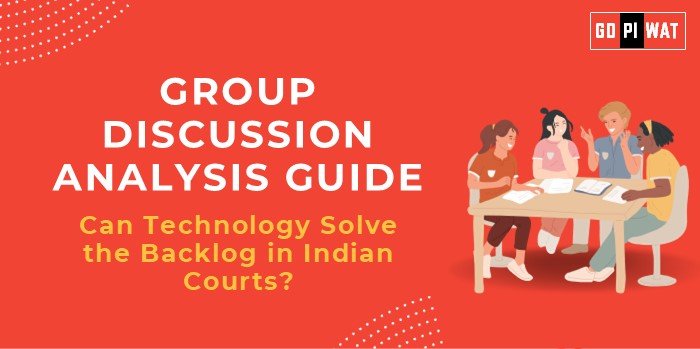📋 Group Discussion (GD) Analysis Guide: Can Technology Solve the Backlog in Indian Courts?
🌐 Introduction to the Topic
- 📜 Opening Context: India’s judiciary faces an overwhelming backlog of over 47 million cases, a crisis that impacts justice delivery and socio-economic stability. Leveraging technology is increasingly seen as a potential game-changer in addressing this issue.
- 📖 Topic Background: The integration of technology in judicial processes, such as e-courts, case management systems, and artificial intelligence (AI), has been adopted globally. India’s judiciary, with its massive scale and unique challenges, provides fertile ground for discussing the feasibility and limits of technological solutions.
📊 Quick Facts and Key Statistics
- 📈 Pending Cases: Over 47 million cases across Indian courts (2024).
- 👩⚖️ Judicial Vacancies: 25% of judicial positions remain unfilled.
- 💻 E-Courts Coverage: 20,000+ courts have implemented e-filing and video conferencing.
- ⏳ Average Case Resolution Time: 3-10 years in lower courts.
- 🌍 Global Benchmark: Estonia resolves cases within 3 months on average using AI-powered court systems.
👥 Stakeholders and Their Roles
- 🏛️ Government: Funds e-courts and policy frameworks.
- ⚖️ Judiciary: Implements technology in court operations.
- 💡 Tech Companies: Develop AI tools and digital infrastructure.
- 🌐 Civil Society: Advocates for transparency and accessibility.
- 🧑⚖️ Legal Fraternity: Adapts to new technology in court proceedings.
🏆 Achievements and Challenges
✨ Achievements
- 💻 E-Courts Initiative: Improved efficiency in filing and hearings for over 20,000 courts.
- 🎥 Video Conferencing Success: Reduced pendency during the pandemic, with 18.4 million virtual hearings conducted (2020-23).
- 🤖 AI Deployment: AI tools like SUPACE (Supreme Court Portal for Assistance in Court Efficiency) are piloted for research and analytics.
- 📊 Digital Case Management: Case Management Systems reduced delays in Delhi District Courts by 30%.
⚠️ Challenges
- 📉 Digital Divide: Limited digital literacy and infrastructure in rural areas.
- 🛑 Resistance to Change: Hesitancy among lawyers and judges to adopt technology.
- 🔓 Cybersecurity Risks: High-profile breaches like the AIIMS ransomware attack highlight vulnerabilities.
- 💰 Financial Constraints: Limited budget allocation for judiciary digitization (₹7,000 crore annually).
Global Comparisons:
• Estonia: Resolves minor disputes using AI and online platforms.
• Singapore: Integrated dispute resolution mechanisms reduce case pendency.
• Kenya: Mobile court systems have improved access in rural areas.
Case Study: Delhi High Court: Implemented digital case management, resulting in faster hearings and reduced delays.
📢 Structured Arguments for Discussion
- 💬 Supporting Stance: “Technology like AI and e-courts can drastically reduce case backlogs by streamlining processes.”
- 🗣️ Opposing Stance: “Without addressing the digital divide and resistance to change, technology alone cannot solve systemic judicial issues.”
- ⚖️ Balanced Perspective: “Technology can significantly aid in reducing backlogs, but its success depends on holistic reforms in judicial administration.”
📈 Effective Discussion Approaches
- 💡 Opening Approaches:
- Start with a statistic: “With over 47 million cases pending, the Indian judiciary needs transformative solutions like technology.”
- Case Study: “Delhi High Court’s adoption of digital tools reduced pendency by 30%.”
- 💡 Counter-Argument Handling:
- Present examples of global successes while acknowledging local challenges such as digital literacy and infrastructure.
📊 Strategic Analysis of Strengths and Weaknesses
Strengths
- 💻 Existing e-courts.
- ✨ Successful pilot projects.
Weaknesses
- 📉 Digital illiteracy.
- 🏚️ Infrastructure gaps.
Opportunities
- 🤖 AI integration.
- 🚐 Mobile court expansion.
Threats
- ⚠️ Data breaches.
- 💰 Cost overruns.
🎓 Connecting with B-School Applications
- 💡 Real-World Applications:
- Digital case studies for operations and governance.
- 💡 Sample Interview Questions:
- “What role can AI play in reducing judicial delays?”
- “How does digitization balance efficiency and accessibility in courts?”
- 💡 Insights for B-School Students:
- Explore judicial reform as a policy innovation area.
- Analyze cost-benefit aspects of technology implementation.


